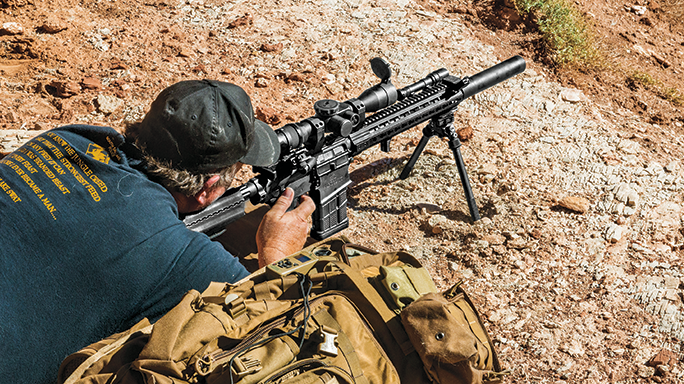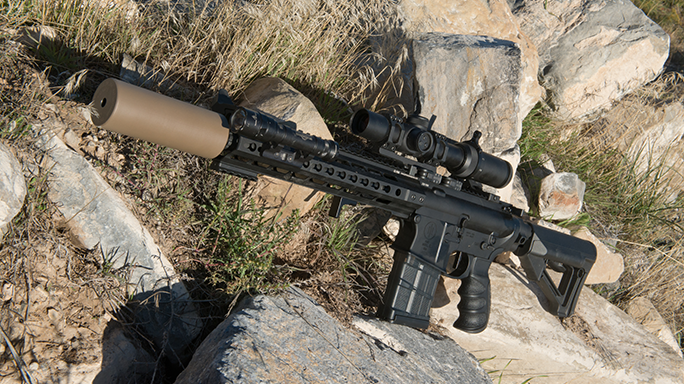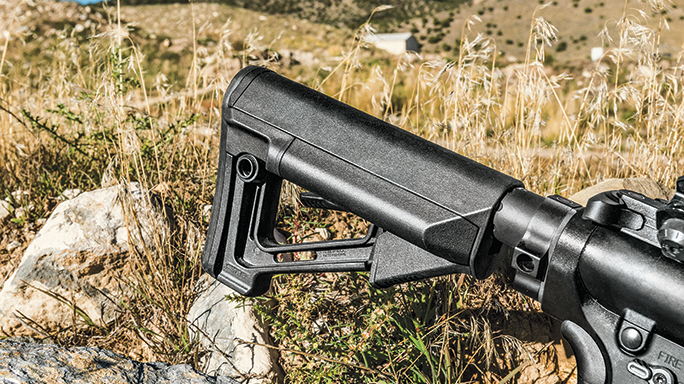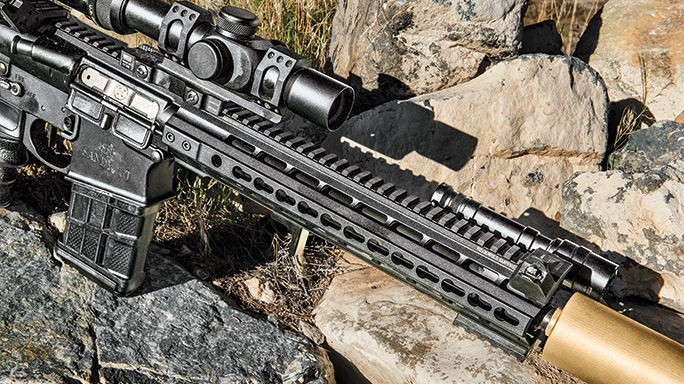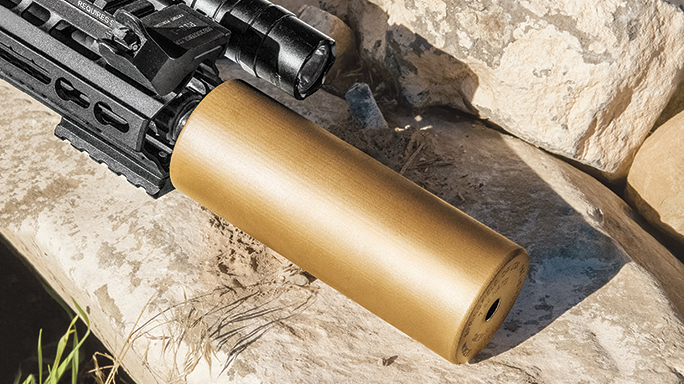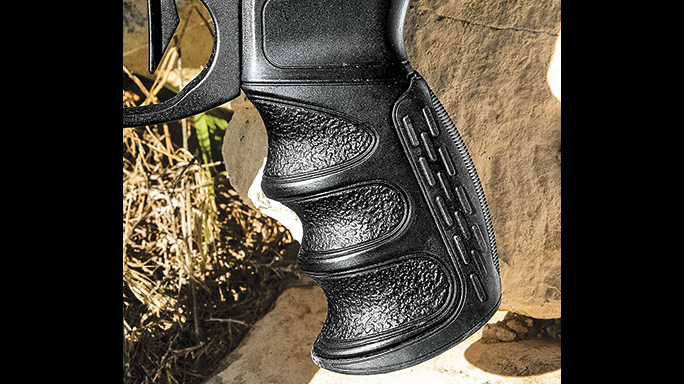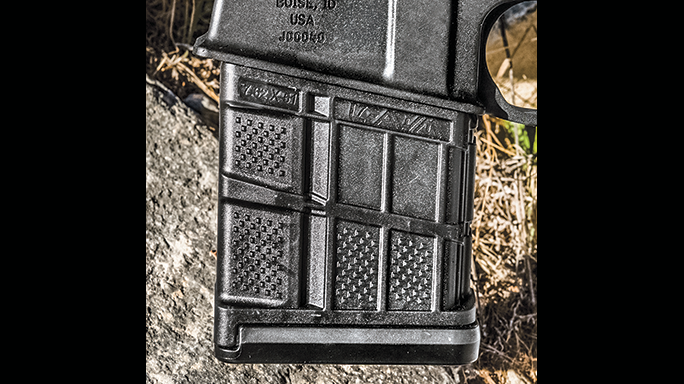The number of ARs chambered in .308 Winchester/7.62mm NATO has increased significantly in the last couple years—and for good reason. Rifles chambered in the venerable 7.62mm NATO are among the most versatile. The ammunition is common, and there’s a bullet type for any specific task. From CQB to target shooting, even at extended ranges, a load built for that purpose exists. And 7.62mm ARs offer minimal recoil while delivering impressive accuracy, especially with match loads. If you could only have one rifle, a 7.62mm is a good choice—something the average hunter has known for decades.
- RELATED VIDEO: New For 2016: Primary Weapons Systems’ MK1 MOD 2 Rifle
The build quality, accuracy and reliability of today’s 7.62mm ARs are approaching 5.56mm AR levels. Not that long ago, you would be lucky to find one that worked. Finding a duty-reliable 7.62mm AR could sometimes be a futile exercise. That has certainly changed, but some big-bore ARs are not without their issues.
Compared to their 5.56mm brethren, 7.62mm ARs can be heavy. Thinner barrels help, along with newer forgings and lightweight materials. They’re also loud and produce significant muzzle blast, even with a flash suppressor, which can be problematic for entry work. The solutions for these issues are easy—in theory. Use quality forgings, shorten the barrel and add a suppressor. Unfortunately, theory and practice are often different.
Advertisement — Continue Reading Below
Gas piston operating systems have largely solved the short barrel issue, with barrels around 12 to 13 inches long being the norm these days. Some require a brake, making them unusable off the range, especially if you’re in close proximity to others. The weight of these rifles is getting better each year.
Suppressing a 12-inch-barreled AR can be a nightmare. One rifle that does it well is the MK212 from Primary Weapons Systems (PWS). Its long-stroke piston operating system lends itself to short barrels in general. Given the correct suppressor, even PWS’ 12.75-inch-barreled 7.62mm AR remains reliable enough for duty, prompting the creation of a suppressor-dedicated rifle—the MK212SD.
Silent Striker
Advertisement — Continue Reading Below
Shortening 7.62mm ARs makes them very handy without compromising their practicality at realistic distances. These rifles can be used across a room or across a field. A 12.75-inch-barreled AR remains plenty lethal at 800 yards. Using a suppressor with a short-barreled AR just makes sense. My standard MK212 works great with a flash suppressor, but I would never field it that way on purpose. It’s tactically unsound and just not pleasant to shoot. At the request of its customers, PWS designed the MK212SD, a simple rifle that only works with a sound suppressor.
PWS’ MK212 rifles start with upper and lower receivers forged from 7075-T6 aluminum, which allows for tighter tolerances, saves weight and adds strength. The MK212SD’s 12.75-inch, chrome-moly barrel has a heavy contour and a 1-in-10-inch twist rate. PWS also furnishes the barrel with enhanced feed ramps before treating it with Isonite QPQ for enhanced surface hardness and corrosion resistance. The low-profile gas block is mounted close to the muzzle with a small port for greater reliability.
Surrounding the gas system and barrel is PWS’ free-floating handguard, which sports a long top rail for adding optics and night vision, KeyMod slots along the sides and bottom for accessories, and four QD sling-attachment points. Mapul’s polymer, flip-up MBUS sights come with the MK212SD.
Advertisement — Continue Reading Below
PWS’ enhanced bolt group has increased mass, extending the dwell time and delaying unlocking. This decreases the chamber pressure for easier extraction. The bolt, designed specifically for this gas piston operating system, is optimized for the 7.62mm NATO. Coated in nickel-Teflon, it is easy to clean and less susceptible to fouling.
The lower receiver includes a flared magazine well and an enlarged triggerguard. PWS also installs its enhanced buffer tube, which is durable, offers QD sling attachment points, prevents carrier tilt and does away with the castle nut. The buffer tube sports a Magpul MOE stock to match the MOE pistol grip. For the MK212SD, PWS uses an H4 buffer and a standard carbine spring. The remaining controls are mil-spec.
For testing the rifle, I replaced the factory trigger with a Geissele Super Dynamic Combat (SD-C) trigger. I also installed a 60-degree Ambidextrous Safety Selector from Battle Arms Development as well as a Scorpion pistol grip from Advanced Technology International (ATI). I tested the MK212SD with its Magpul stock as well as one from Vltor, and I replaced the factory recoil spring with Sprinco’s Orange spring. Finally, I added PRI’s Gas Buster charging handle to prevent any excess gas. I used Lancer’s new 20-round L7AWM magazines for the bulk of the testing. When necessary, I used a Blue Force Gear sling as well as an Atlas bipod.
Advertisement — Continue Reading Below
Rapid Fire
My testing of the MK212SD was all about its practical application as a police rifle, putting reliability at the top of the list. I started by running the MK212SD under rapid fire with several types of ammunition from 10 to 400 yards. I used a U.S. Optics 1-8X SR-8C scope for this portion of the evaluation. The scope’s illuminated red dot allows for CQB use, while the mil-lined reticle provides holds for longer distances. The scope’s knobs offer mil adjustments. I also used Dueck Defense offset sight for backup targeting.
Several suppressors were tested, including a SilencerCo Saker 762, a SureFire SOCOM762-MINI, a Yankee Hill Machine Phantom, a Delta P Design Brevis and a Gemtech Sandstorm. Delta P Design’s Brevis suppressor really ruled during the testing. The MK212SD was noticeably softer to shoot, with consistent brass ejection no matter the ammunition used. No excess gas was sent my way, either. The suppressor also tended to cool more quickly, and the rifle remained flawless no matter how fast I pulled the trigger. Moving around barricades, around my truck, and over and around walls, the rifle was truly easy to handle. Working in my range’s shoothouse or out to 400 yards, the Brevis/MK212SD combination was perfect for me.
Advertisement — Continue Reading Below
Producing tiny groups at 100 yards means little if the rifle won’t hold that kind of consistency throughout its entire range. Accurately testing this premise, however, requires a long range, some software and maybe some help from an expert. A trip to meet Buck Doyle of Follow Through Consulting at his range in Teasdale, Utah, took care of it all.
Buck Doyle is friends with Todd Hodnett, a leading sniper instructor and ballistics guru. Todd’s training, coupled with Bryan Litz’s Applied Ballistics program, is recognized as state of the art by our most elite military units. Recent training with Chase Stroud, a world-class precision rifle competitor, would indicate that the competitive world thinks the same way. The best setup these days is to load the Applied Ballistics software into a Kestrel weather station. Buck’s range allowed us to properly true the rifle using this device and test its accuracy at the realistic limits of its range.
Hiking up a short hill, we ended up in a slot that looked down a beautiful valley with steel targets placed at ranges designed for this gun and caliber. For these distances, we used a U.S. Optics MR10 1.8-10x scope in a set of Seekins Precision rings. The scope features Horus’ H425 reticle, which allows for wind and elevation holds at longer distances. We placed a 6-inch steel target at 100 yards to confirm our zero, then 765 meters for truing.
Advertisement — Continue Reading Below
Using the Gemtech suppressor, my first hit was dead center at 100 yards. The Sandstorm is lightweight and very quiet—perfect for precision rifle applications. Moving to 765 meters, I fired several shots and achieved dead-center hits on steel using an 8.4-mil hold. U.S. Optics’ glass and the Horus H-425 reticle made solid holds easy and consistent. I placed this hold and range into the Kestrel system to obtain an accurate range card, which I then tested by consistently hitting 12-inch plates between 200 and 600 meters. Getting first-round hits on each, the rifle was trued for this ammunition with an accurate range card. Just enter the atmospheric conditions for the area you are in and the Applied Ballistics software does the rest.
Along with truing the rifle, we tested its combat accuracy at distance. Ideally, you want it to hold close to 1 MOA at range. Once the 8.4-mil hold was confirmed, I fired a four-round group at a sustained rate of fire. With a 0.3-mil hold, the rifle was not only true, but it also held 1 MOA out to 765 meters (roughly 850 yards). That, coupled with consistent first-round hits from 200 to 600 yards, gives you a true indication of the rifle’s real-world accuracy.
Sub-MOA Results
Advertisement — Continue Reading Below
This rifle’s typical range accuracy was impressive. Hornady’s 155-grain TAP ammo produced the best group at 0.7 inches while using the Gemtech Sandstorm suppressor. Everything was sub-1-inch, with most groups under 0.75 inches. Testing at 400 yards with the TAP yielded a 3-inch group, making this an easy 1-MOA range gun with solid match ammunition.
- RELATED STORY: Gun Test: Primary Weapons Systems’ MK116 5.56mm Rifle
Ultimately, this is a great rifle. It was flawless, accurate and comfortable to shoot. This is one of the softest-shooting suppressed 7.62mm ARs I’ve ever used, and it’s a fine example PWS’ continuing emphasis on simple reliability.
For more information, call 208-344-5217 or visit primaryweapons.com.
Advertisement — Continue Reading Below
Specifications
- Caliber: 7.62mm NATO
- Barrel: 12.75 inches
- OA Length: 27.5 inches
- Weight: 8.81 pounds (empty)
- Stock: Magpul MOE
- Sights: Magpul MBUS
- Action: Piston-operated semi-auto
- Finish: Matte black
- Capacity: 20+1
- MSRP: $2,600
